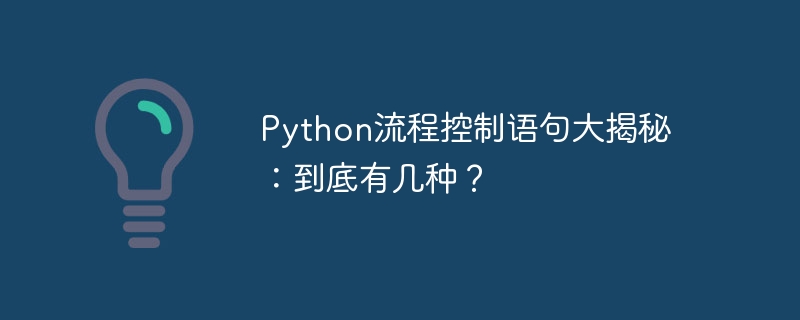

As a high-level programming language, Python is favored by developers for its simplicity, clarity and readability. In Python, flow control statements are an essential and important part of writing programs. This article will give you an in-depth understanding of the types of flow control statements in Python and their specific code examples, helping you better master Python programming skills.
In Python, flow control statements are mainly divided into three types: sequential structure, conditional structure and loop structure. Each structure has its own unique characteristics and uses.
First of all, the sequential structure is the most basic structure and the structure that the program executes by default. It executes the code sequentially from top to bottom without any conditional judgment or loop operation. The following is a simple sequential structure example code:
def sum(a, b):
result = a + b
return result
num1 = 10
num2 = 5
result = sum(num1, num2)
print("两个数的和为:", result) In the above code, a function named sum is first defined to calculate the sum of two numbers. Then two variables num1 and num2 are defined and assigned values of 10 and 5 respectively. Then call the sum function and assign the result to the result variable. Finally, the final result is output through the print function. It can be seen that the code is executed from top to bottom in order without any conditional judgment and loop operation.
Secondly, the conditional structure executes different code blocks based on different conditions. Conditional statements in Python mainly include if statements, if-else statements and if-elif-else statements. The following is a simple conditional structure example code:
age = 18
if age >= 18:
print("成年人")
else:
print("未成年人")In the above code, a variable age is first defined and assigned a value of 18. Then use the if statement to determine whether the value of age is greater than or equal to 18. If the condition is met, the code block after the if is executed; otherwise, the code block after the else is executed. In this example, since age is equal to 18, the output is "Adult".
In addition, the loop structure is to repeatedly execute a certain piece of code based on certain conditions. Loop statements in Python mainly include while loops and for loops. The following is a simple loop structure example code:
num = 1
while num <= 5:
print("当前数字是:", num)
num += 1 In the above code, a variable num is first defined and assigned a value of 1. Then use the while loop to determine whether the value of num is less than or equal to 5. If the condition is met, the code block within the loop is executed, and num is changed after each loop. Add 1 to the value of . When num is greater than 5, the loop ends. In this example, the numbers 1 to 5 are output within the loop.
Through the above example code, we can see that there are various types of process control statements in Python, which are suitable for different scenarios and needs. Mastering the use of these statements can help us write programs more flexibly.
To sum up, flow control statements in Python include sequential structures, conditional structures and loop structures. The sequential structure executes the code in order from top to bottom; the conditional structure executes different blocks of code according to different conditions; the loop structure repeatedly executes a certain piece of code according to certain conditions. By flexibly using these structures, we can write more efficient and powerful Python programs. Whether you are a beginner or an experienced developer, you should have a deep understanding of and master these important flow control statements.
The above is the detailed content of In-depth analysis of Python flow control statements: How many classifications are there?. For more information, please follow other related articles on the PHP Chinese website!
 What is the use of java
What is the use of java
 Domestic Bitcoin buying and selling platform
Domestic Bitcoin buying and selling platform
 psrpc.dll not found solution
psrpc.dll not found solution
 Three mainstream frameworks for web front-end
Three mainstream frameworks for web front-end
 The difference between indexof and includes
The difference between indexof and includes
 How to calculate the factorial of a number in python
How to calculate the factorial of a number in python
 Computer system vulnerability repair methods
Computer system vulnerability repair methods
 How to solve the problem of access denied when booting up Windows 10
How to solve the problem of access denied when booting up Windows 10
 Latest ranking of digital currency exchanges
Latest ranking of digital currency exchanges




